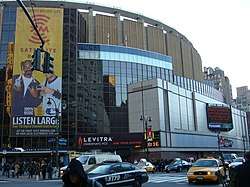Louis Armstrong Stadium
Louis Armstrong Stadium is a 14,000-seat tennis stadium at the USTA Billie Jean King National Tennis Center, one of the venues of the US Open. It opened for the 2018 US Open as a replacement for the 1978 stadium of the same name. It is named after jazz musician Louis Armstrong who lived nearby until his death in 1971.
 | |

| |
| Location | USTA Billie Jean King National Tennis Center, Flushing, Queens, New York City |
|---|---|
| Coordinates | 40.751085°N 73.845515°W |
| Owner | USTA |
| Capacity | 14,053[1] |
| Surface | DecoTurf |
| Construction | |
| Opened | 2018 |
| Architect | Rossetti Architects |
| Tenants | |
| US Open (USTA) (2018–present) | |
Features
The stadium has a retractable roof, the largest of its kind among the No. 2 stadiums at Grand Slam venues. At the time of its opening it was the 13th largest tennis venue in the world (based on capacity). It is the first tennis stadium to have a roof and be naturally ventilated.[2] Designers say the terra cotta material contextually relates to the traditional brick buildings on the site while using the material in a new way.[3]
History
Construction
The former Louis Armstrong Stadium was demolished following the 2016 US Open.[4] For the 2017 tournament, while construction was still ongoing on the new stadium, a temporary 8,800-seat stadium was built on the site of the demolished ticket office and East Gate entrance, on Parking Lot B, close to the boardwalk ramp to the subway and LIRR trains.[5]
Opening
The stadium was opened on August 22, 2018, when John and Patrick McEnroe played an exhibition against James Blake and Michael Chang.[6] The first official match was played during the US Open on August 27, 2018, between Simona Halep and Kaia Kanepi. Kanepi won in two sets, which was the first time a WTA No. 1 had ever lost in the first round of the US Open.[7]
References
- Perrotta, Tom (August 29, 2018). "U.S. Open Adds New Camera Position in Armstrong Stadium". The Wall Street Journal. Retrieved August 29, 2018.
- https://www.theguardian.com/sport/2018/aug/24/us-open-new-louis-armstrong-stadium-600m-rebuild
- https://archpaper.com/2018/08/louis-armstrong-stadium/
- Newcomb, Tim (August 24, 2018). "The borough's most famous arena: Louis Armstrong Stadium, version 2.0". Tennis.com. Retrieved July 22, 2019.
- "Louis Armstrong Stadium: December 2016 update". USOpen.org.
- https://www.usopen.org/en_US/news/articles/2018-08-22/2018-08-22_new_louis_armstrong_stadium_officially_opened.html
- "Kaia Kanepi sends No. 1 Simona Halep home in stunner". USOpen.org.



